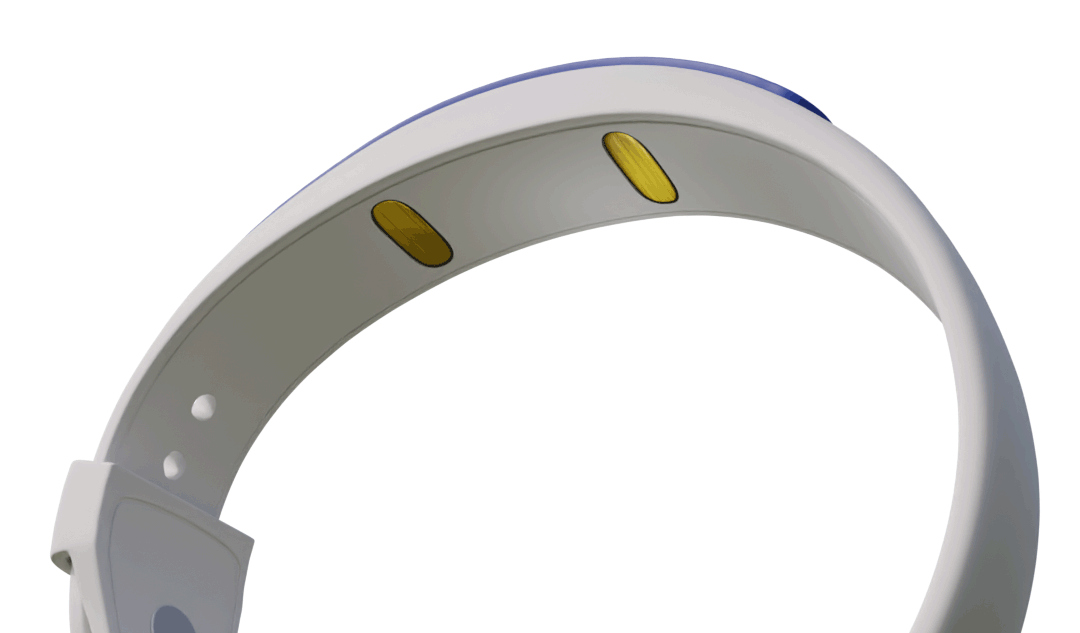TECHNOLOGY
MEASURING WITHDRAWAL
Our device uses the two physiological signs of withdrawal described above: blood pressure variability and changes in skin conductance in order to recognize signs of withdrawals and offers to administer appropriate medication. Baseline blood pressure and conductance are first measured when the user subjectively feels no withdrawal symptoms. Following that, a significant change in blood pressure will trigger the eBand to measure skin conductance, and if both parameters are statistically altered, a medication trigger prompt will be generated.


HOW BLOOD PRESSURE
IS MEASURED
A person’s blood pressure is an important factor for identifying withdrawal. Our device uses a photonic integrated circuit (PIC) and laser Doppler vibrometers (LDV) to measure the blood pressure in a non-contact manner from simply wearing the device. LDV is a “vibration-sensing” technique that measures the velocity of a vibrating target, using a laser beam, and can accurately measure blood pressure. The PIC has allowed this technology to be produced in a compact and sleek manner, fitting inside the device.

HOW SKIN CONDUCTANCE IS MEASURED
Skin conductance is the other key factor that our device needs to detect nicotine withdrawal. Skin conductance has a positive relationship with both chronic and acute stress levels, which in turn have a positive relationship with nicotine withdrawal. The skin conductance sensor uses a bipolar recording method to measure the electric current change due to conductance change for the constant electric voltage supplied to two electrodes of the sensor. The electrodes of the conductance sensor need a large contact area with the skin, in order to cover as many sweat glands as possible. The electrode is designed to be 7.5 mm x 8.5 mm to create a contact area of 63.75 mm2 with the skin.

STRESS LEVEL AND NICOTINE NEED MEASUREMENT

Timescale
Nicotine dependency recovery curve
Blood pressure
Skin conductance
Medication release range
Our device releases medication only when it is really needed while continuously decreasing the amount released to reduce the level of dependency for the person.
WHEN MEDICATION IS RELEASED
Quantitative stress measurement using the two parameters described above allows for the release of medication that is proportional to the withdrawal response, thus allowing a regressive pattern of nicotine use. As could be seen from the graph below, skin conductance in subjects changed by a factor of 0.09 after the deprived smokers received their dose of nicotine. Deriving from this, eBand is calibrated to shut off nicotine delivery once the skin conductance has been altered by 0.09 μS.

Medication is delivered via electrically driven flow through nanochannels called densely packed Multiwalled Carbon Nano Tubes (MWCT). For this, a Pt wire is inserted into the droplet of liquid medication to establish electrical contact, making the tube membrane the anode (positive potential) and the Pt wire the cathode (negative potential). When a Voltage threshold of 1.7V is reached, the droplet rapidly transitions from a superhydrophobic state to a hydrophilic state, thus releasing the droplet through the MWCT and onto the skin where it is gradually absorbed.
HOW MEDICATION
IS RELEASED

.png)
eBand COMPARISON CHART
e-Band


Chrono Therapeutics

Somatix Smoke Beat

Conventional nicotine
replacement therapies
(e.g. patch, gum, vape)
Ongoing monitoring of physiological
withdrawal signs
Automatic
medication
release
Misuse prevention
through the smart, adaptive nicotine release mechanism
Precise and efficient medication delivery using Multiwalled Cabon Nano Tubes
Nicotine and Bupropion cartridges
are available
Automatically
tracks progress
and adjusts therapy
Automatically decreases doses
as physiological withdrawal
signs decrease
Only offers timed delivery of medication and gradual decrease, not dependent on physiological signs of withdrawal
Some methods
Some methods